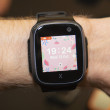Review: Plantronics BackBeat Go 3
Apr 29, 2016, 3:45 PM by Eric M. Zeman

The Plantronics BackBeat Go 3 are lightweight stereo Bluetooth headphones that offer a portable design and excellent battery life. This third-generation headset is ideal for use around town when you don't want wires dragging you down. Here is Phonescoop's in-depth review.
Who Is This For?
Plantronics BackBeat Go 3 Bluetooth headphones are for active people who favor portability, sweat resistance, and battery life over pure sound quality.
Preamble
Listening to music from your smartphone has never been better. Nor has it been more complicated. You're likely to find several aisles full of headphones, headsets, speakers, and other audio products at your local electronics store. The huge selection can be overwhelming.
Picking the right pair of headphones is best approached based on how you plan to use them. For example, if you're planning to spend an evening losing yourself to Pink Floyd while sitting on the couch, perhaps some traditional, comfy, over-the-ear cans will do. Catching the latest jams while riding the subway to work? Maybe a set of small earbuds will be best. Headed out for a brisk evening walk? Well, Plantronics has an idea about what might work.
The BackBeat Go 3 headphones have a pretty clear use case: They are in-ear, wireless headphones that target movers and shakers, but not necessarily hardcore fitness buffs. There are dozens of competing Bluetooth headphones that cover this same ground.

Form Factor
The Go 3 are a solid update to the Go 2 headphones from Plantronics, but carry forward the same essential form factor. The Go 3 are formed by two earbuds connected by a cable. The earbuds go in your ear and the cable either hangs below your chin or drapes behind your neck, depending on your preference. The battery is stuffed into one of the earbuds, rather than within the cable, and a set of controls with a microphone are positioned closer to the right ear. This is pretty standard stuff.

The earbuds are sizable. The main module for each is fairly big, but thankfully lightweight at 0.67 ounces. You might look at them and think, "That's not going to fit in my ear!" Don't worry: they will.
Plantronics said it revised the Go 3's to make them fit better in the ear, and, more importantly, comfortable to wear over an extended period of time. Plantronics included three sets of eartips with the Go 3 to help ensure most people can find a comfortable fit. Unlike the Go 2's, the Go 3's include a rubber stabilizer loop that fits into the earlobe to help hold the headphones in place.
The smallest set of eartips is installed on the Go 3's out of the box. These didn't work for me. I definitely recommend you spend time selecting the tips that give you the most comfortable fit and provide a tight seal in the ear canal. (This is vital. I'll explain why later.)
Changing the eartips should be simple. Most often, rubber, foam, or silicon tips are fitted over the portion of the headphones inserted into the ear canal. They normally slip on and off. The tips included with the Go 3 have a plastic ring that snaps them into the headset. This helps them remain firmly attached to the headset, but makes them far more difficult to remove. In fact, I almost broke the Go 3s attempting to remove the tips. This should be easier.
Ear Tips
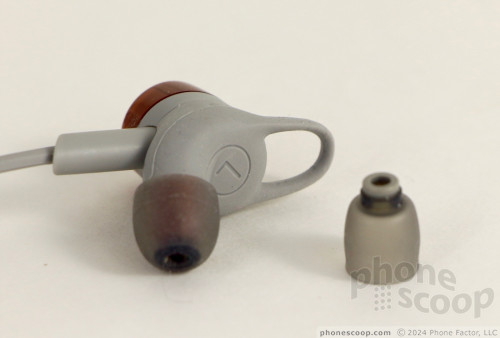
One of the earbuds has a micro-USB port for charging, covered by a removable cap. A notch for your fingernail helps pry the cap loose. It has a tether so it won't fall off and get lost.
Charging Cap
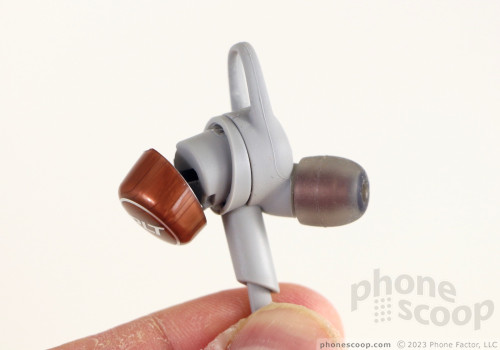
The Go 3's are made from plastics and silicon. The cable is flat, which means it won't tangle as easily. I appreciate that. They are light enough that, once positioned comfortably in your ear, they will essentially vanish and you'll forget you're wearing them. For a set of $99 headphones, they are manufactured well enough, although I would have preferred to see some tighter seams.
Basic Use
Plantronics recommends users angle the cable attached to each earbud facing forward a bit when inserting the Go 3. This will position the tips in your ear canal correctly and also allow the stabilizer loop to properly catch the inside of your ear. The Go 3's don't include different stabilizer sizes; thankfully, they fit me well enough as-is.
Ear Loop
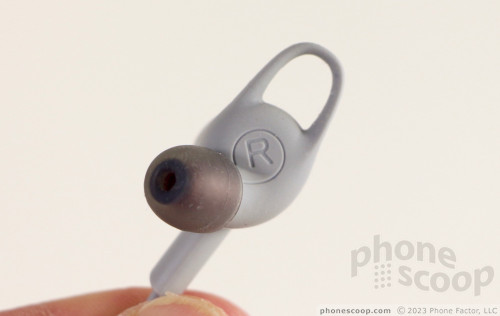
With the earbud cable angled forward, it is more natural for the cable to dangle below your chin. This also makes it easier to reach the controls for adjusting volume, skipping tracks, and accepting calls. However, I found it much more to comfortable to drape the cable behind my neck, even though this made the controls more difficult to locate quickly with my hand. Where you position the cable will boil down to personal preference. The controls themselves are easy to decipher without looking thanks to their generous profiles. The three buttons provide satisfying travel and feedback.
Controls
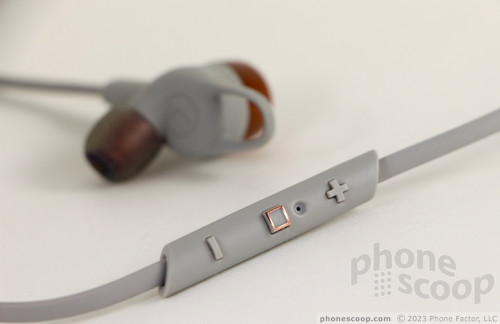
Once you've found the tips and wearing style that work for you, it's time to connect the headphones and get started. Plantronics has done some great stuff with the software in order to help you pair the Go 3's to your phone.
With the headphones in your ear and your phone's Bluetooth on, a long-press of the power (main) button on the control strip — about 1-3 seconds — turns the Go 3's on. You have to press-and-hold for about 5 seconds to put the Go 3s in pairing mode. You'll hear voice prompts to let you know what's going on. When turned on, the Go 3's say "power on" and "battery full" or "battery low" depending on the battery's status. The Go 3's will also tell you when you're in pairing mode. A beep and voice confirmation lets you know you're good to go. I had absolutely no trouble pairing the Go 3's with an iPhone, iPad, and various Android smartphones and tablets. I like that when you resume music playback, the Go 3's tell you how much more listening time the battery can provide.
The Go 3's were comfortable enough to wear that I was able to listen to music for hours without any fatigue. Despite working up a light sweat while walking on the treadmill, the Go 3's remained sealed tightly in my ear.
Fit
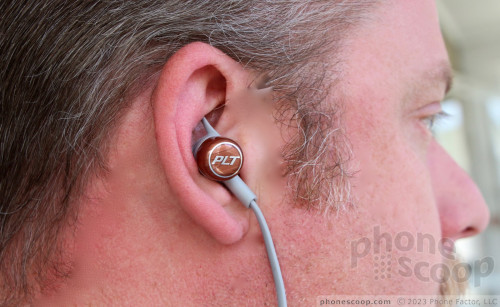
Performance
Plantronics increased the size of the drivers in the Go 3 when compared to the Go 2. The Go 3's include a 6mm driver with a frequency response between 20 and 20,000 Hz. The in-ear design and eartip seal provide 20 dB of passive noise reduction, meaning they mute out the outside world at least a little bit so you can hear your music better at lower volumes.
The headphones use the A2DP 1.2 Bluetooth profile to provide stereo sound, but rely on a custom SBC (subband coding) codec rather than something more common like aptX. Plantronics claims its codec is very high quality.
I think the BackBeat Go 3s sound very good, but not great.
I tested the Go 3's with a range of different music styles, including rock, orchestral, jazz, EDM, and also made sure I used a flat EQ throughout to truly understand the tone and range produced by the Go 3's without any help from the associated music app.
As I noted earlier, creating and maintaining a tight seal between the eartip and your ear is essential. Without that seal in place, you'll hear almost no bass at all. With a proper seal, the Go 3's tend to favor mid- and high-frequency sounds. Bass is present, but it's not quite as deep or punchy as I'd like it to be. The upper frequencies sounded clear without being overly sharp or shrill.
At their loudest, the Go 3's will probably stop short of producing hearing damage, but this also depends on the volume level you set on your phone. The passive noise reduction means you can get away with listening at a comfortable level and still hear your music when standing on a subway platform near an arriving train. Most people should be pleased with the Go 3's range as far as volume is concerned.
I also tested a few phone calls. The Go 3's were excellent for taking calls.
Battery life is excellent. The 180 mAh battery is good enough to provide about 6.5 hours of playback time — that's enough to cover a flight from New York to LA — and two weeks of standby time.
Moreover, the Go 3's can be bundled with an optional pouch that contains a battery and charger. The pouch/charger has enough capacity to fully recharge the Go 3's twice while you're away from an outlet. My one gripe is charging time. It takes close to three hours for the Go 3's to recharge, where you use a wall outlet or the pouch.
Wrap-Up
Headphones are often beset with compromises. To get the best sound, you really want big cans that can push more air, but they are often impractical to carry around. In-ear headsets such as the Plantronics BackBeat Go 3 are easy to tote around and use, and still manage to deliver a respectable music experience.
The Go 3's are a good entry from Plantronics and a huge upgrade when compared to the company's earlier in-ear headphones. The design allows them to be worn for hours without suffering from ear fatigue, the sound is decent, and battery life is superb.
I like the BackBeat Go 3's enough to recommend them to anyone looking for a pair of portable stereo Bluetooth headphones. At $99, they are reasonably priced, though I'd spend another $30 to get the carrying pouch with built-in charger.

Comments
No messages






 Samsung Refreshes Galaxy S Series with S Pen, New Cameras
Samsung Refreshes Galaxy S Series with S Pen, New Cameras
 iPhone 14 Plus Offers a Big Screen For Less
iPhone 14 Plus Offers a Big Screen For Less
 iPhone 15 Series Goes All-In on USB-C and Dynamic Island
iPhone 15 Series Goes All-In on USB-C and Dynamic Island
 Motorola Adds 5G to the Moto G Stylus
Motorola Adds 5G to the Moto G Stylus
 TCL Launches 20 Series in US
TCL Launches 20 Series in US
